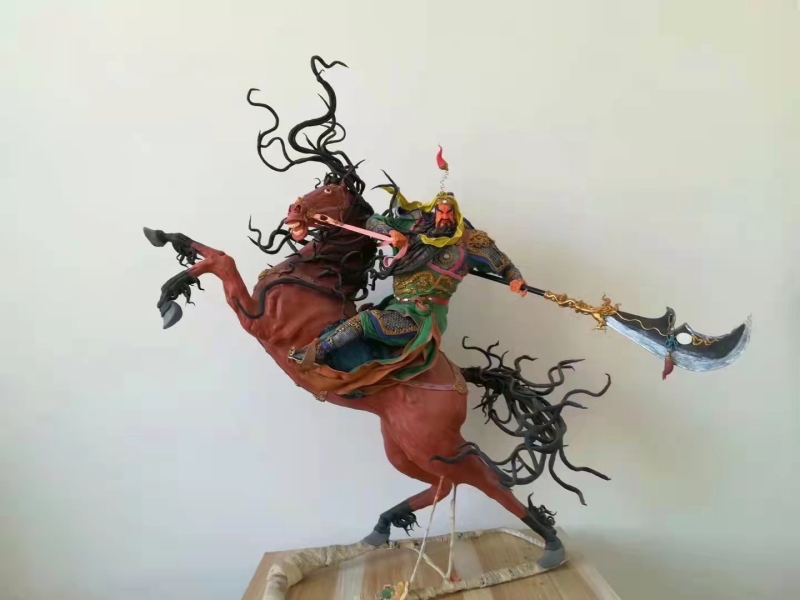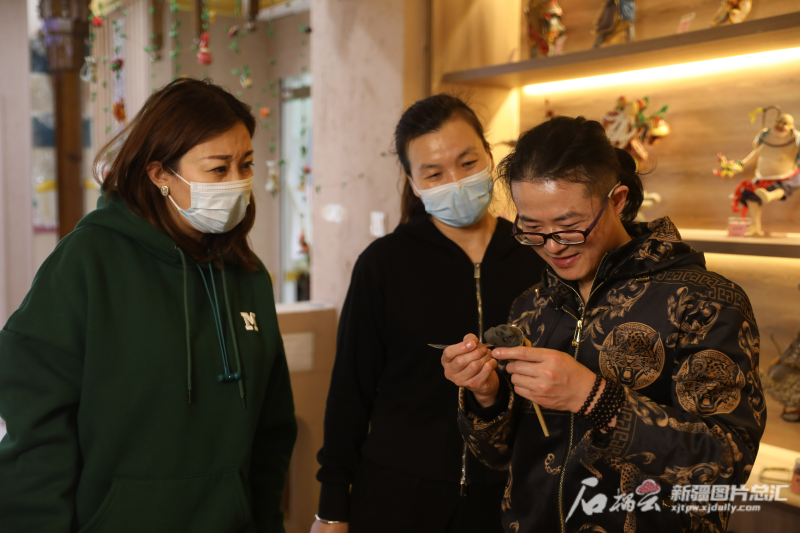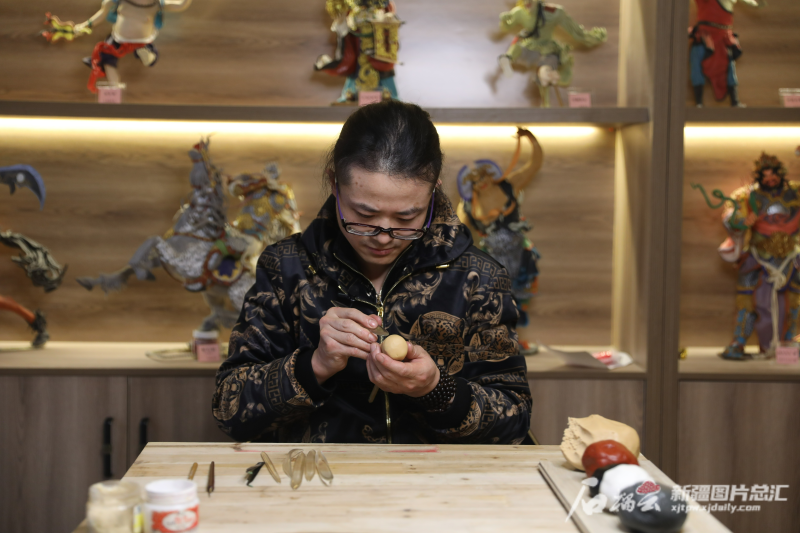After kneading, putting together, moulding and carving more than 140 modules for three days, a sixty-centimeter-high dough sculpture of Guan Yu (a Chinese military general serving under the warlord Liu Bei during the late Eastern Han Dynasty of China), holding his crescent blade horizontally and riding on a prancing horse, is created by twenty-seven-year-old Zhang Jinjun.
As a representative trustee of dough sculpture skills of Urumqi, capital city of NW China’s Xinjiang, Zhang Jinjun sets high standards for his works. They should be large and their height should be over 30 centimeters; they should look lifelike and the themes of the works should reflect excellent traditional Chinese cultures. At present, the biggest one of his dough sculpture works is 1.2 meters high.

Photo shows the Guan Yu dough sculpture that was of a height of 1.2 meters. (Photo offered by Zhang Jinjun)
According to historical records and cultural relics research, Chinese dough sculpture first appeared in Han Dynasty, and dough figurines have also been unearthed at the Astana ancient tomb complex in Turpan City, northwest China’s Xinjiang. Developing for thousands of years, different kneading styles have been evolved in southern and northern China. Shanxi Province and Heze City in Shandong Province feature passion and impasto in color, while Shanghai is featured by its exquisiteness and delicacy.
Over the past ten years, dough sculpture skills across the country have been listed as the national intangible cultural heritage representative items.
Zhang’s works show more northern China way on style, whether it is the characters from the four great classic Chinese novels, including Journey to the West, Romance of the Three Kingdoms, A Dream in Red Mansions, and Water Margin, or elements of myths and legends, or birds and animals, they are all full of vitality. “Body language is the key to bring dough sculptures vitality. when I was a student learning painting in Guangzhou Academy of Fine Arts, I practiced body sketching and coloring intensively.” Zhang told the reporter while pointing at his works at the dough sculpture area in the Xinjiang Intangible Cultural Heritage Museum. Flowing long beard, waving capes, angry or happy faces, vigorous or wild gestures and moves, are expressed on dozens of vivid dough sculptures made by Zhang, including Guan Yu, Zhao Yun (a military general who lived during the late Eastern Han Dynasty and early Three Kingdoms period of China), Zhong Kui (a deity in Chinese mythology, traditionally regarded as a vanquisher of ghosts and evil beings), Ji Gong (a Chan Buddhist monk who lived in the Southern Song Dynasty) and Buddha Mile.

Photo shows Zhang Jinjun explains and displays a dough sculpture for enthusiasts at the Xinjiang Intangible Cultural Heritage Museum in Urumqi, northwest China’s Xinjiang. (Photo by Zhong Zhaofeng/ Shiliuyun-Xinjiang Daily)
“Dough is fundamental for making large-scale sculpture, so I have made a lot of efforts on making dough to ensure it won’t crack because of desiccation, crash or collision.” Zhang said, “Glue, preservative, grease and pigment will be used when making dough. Proportion matters a lot, and it requires a constant trying and research to get perfect dough.”
Zhong Kui is Zhang’s favorite character. He began to carve the face of Zhong Kui sculpture when talking to the reporter. He took a transparent plastic sculpture tool to shape the flesh-colored round dough on a stick, served as a pillar, to make the head and face of Zhong Kui.
“Facial expression is the key to make Zhong Kui look lifelike. According to the myth, Zhong Kui looks ugly and fierce, so I need to show his distorted wrinkles. Besides, his messy hair and exaggerated curly beard are key features to make the figure vivid.” Zhang believes that as long as the most distinctive features have been captured, can he make dough sculptures look alive.

Photo shows Zhang Jinjun makes the face of Zhong Kui dough sculpture at the operation and demonstration area of the Xinjiang Intangible Cultural Heritage Museum in Urumqi, northwest China’s Xinjiang. (Photo by Zhong Zhaofeng/ Shiliuyun-Xinjiang Daily)
His hands are too rough and hard to match the fine and smooth skin of his face, especially the thumbs and index fingers that are used too hard and often. “I started kneading dough at a very young age,which has costed me too much strength.”
Like many inheritors of intangible cultural heritage, the influence and support of his fathers was an important factor to let him embark on this path. “My father and grandfather liked kneading clay, they may not be as professional as craftsmen, but they contributed a lot of their spare time to making clay figures. I was obsessed with it after long-term watching and learning in such atmosphere.” At sixteen, when he said he wanted to make something great by kneading clay and making dough figures, everyone surrounding him thought he was insane and would only waste flour.
“But my father supported me a lot. He also reached to master Xiao, a craftsman of dough sculpture in Shenzhen through his friend and sent me to learn from him.” said Zhang, “My father said that the master may teach you techniques, but the craft should be researched by yourself so as to be able to earn a living with it.”

Photo shows Zhang Jinjun makes dough sculpture at the operation and demonstration area of the Xinjiang Intangible Cultural Heritage Museum. (Photo by Zhong Zhaofeng / Shiliuyun-Xinjiang Daily)
“How to make a living by craft” is a long-term problem faced by inheritors of intangible heritages, but Zhang has no worry about this. “The supporting policies to inheritors of intangible cultural heritage implemented by China and the platforms built for inheritors have given me confidence to carry this skill forward.” said Zhang Jinjun.As an inheritor, he is always invited to attend cultural events, intangible cultural heritage exhibitions and traditional cultural exhibitions to teach his skills, and now he is also a teacher of more than 20 students of all ages.
According to statistics, there are currently more than 250 places for intangible cultural heritage exhibition and inheritance venues in Xinjiang, providing platforms for inheritors and enthusiasts to exchange and impart their ideas and skills to each other.In addition, Xinjiang Uygur Autonomous Region also continues to promote the excavation and cultivation of intangible cultural heritage inheritors, selects and sends inheritors to domestic universities to participate in special training, and encourages them to recruit apprentices through special fund subsidies.
Zhang’s confidence comes from his life plans set very early. “ As an hotel chef, I’m allowed to use my dough sculpture skills effectively,for example, I am very skillful on plate setting, like carving food and making different-shaped pastry.”He said, only by excavating the practical value of dough sculpture to the greater extent and bringing them into people’s life, can the skills be inherited better.









